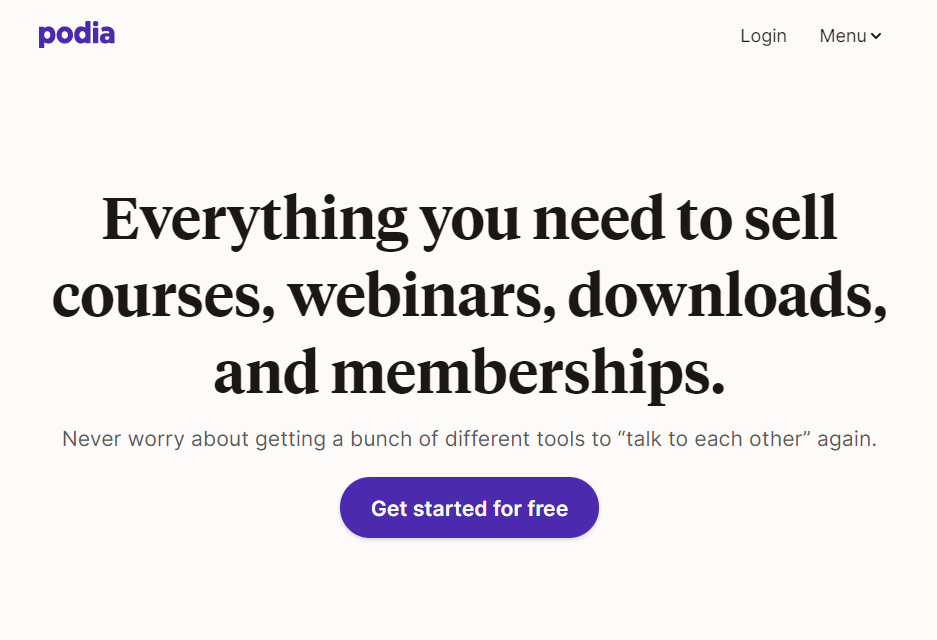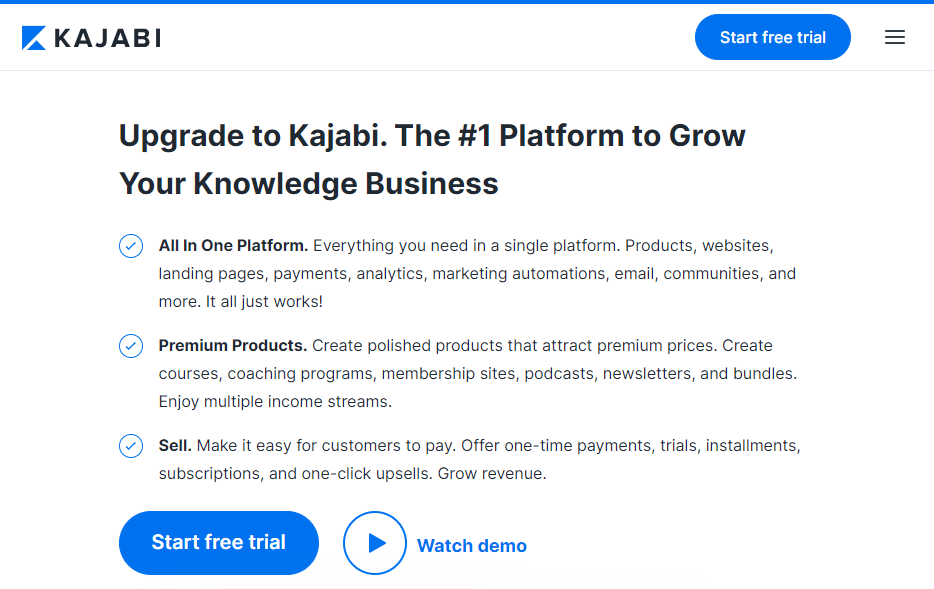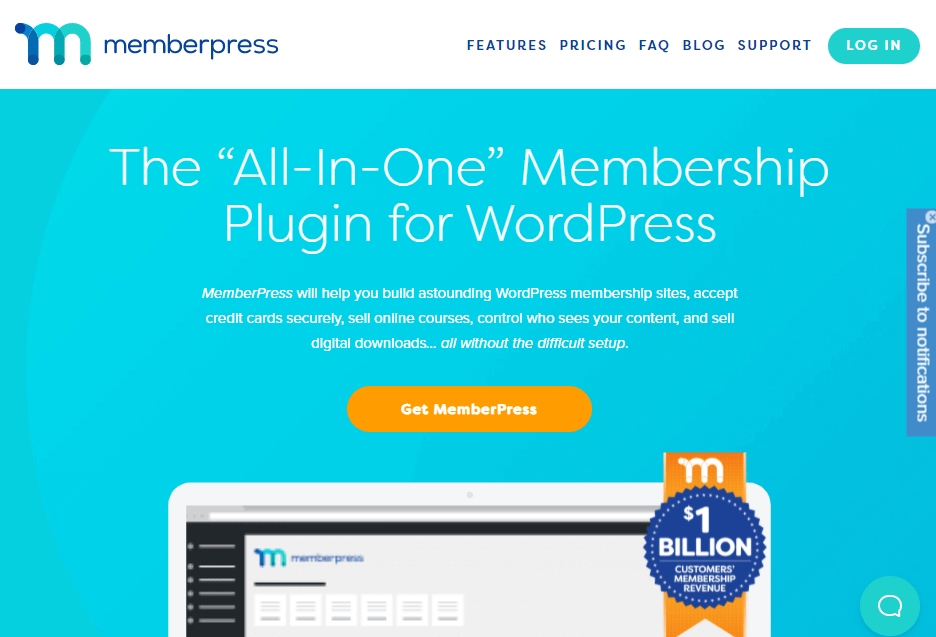What is the effortless way to increase user engagement? Having a membership site! Visitor engagement is important for growing customer relationships and increasing profitability. Research shows that if you can keep your users engaged, profitability as well as customer relations grow by 23%!
There are several metrics that you can use for learning just how engaged your users are. Some of those metrics include the time they spend on your site, the comments they leave, the bounce rate you have, the number of shares your content is receiving, and so on.
Yes, it is true that you can always use content for engaging customers, but the other simple thing you can do is introduce membership options. Membership usually comes with different perks like discounts, access to restricted or gated content, and so on. Once you convert your readers into members, they will engage more with your content, thereby reducing bounce rate, and probably increase social shares, comments, and so on.
What is interesting is that members are far more likely to come back to your site and engage with your content. They are also far more likely to browse longer and make more purchases (if you are offering something to purchase).
Even better, membership can open a new income channel for your site if you start charging for membership. As long as your gated content is amazing and what you have to offer is something people like or need, your site users are likely to purchase a membership.
In case you are thinking that building a membership site is not easy, you cannot be more wrong. There are many platforms that will allow you to easily create membership sites without the need for having any coding knowledge.
Yes, you can build a membership site using WordPress, but if you want to avoid WordPress, there are several platforms that can help you.
In this article, I am going to give you the list of best membership site platforms that you can use for easily building your first or next awesome membership site.
Are you ready?
But before we start with the list, let us go through the answers to a few important questions that you are likely to ask.
What is the difference between a subscription site and a membership site?
A subscription site is a type in which your readers or users will accept and enter a financial contract, wherein they will agree to pay a certain amount of month at a predefined time interval. For instance, if you are using Netflix, you are most likely paying a monthly fee to access all the content they have to offer.
A membership site may or not have a financial contract in play. If there is a financial contract, it may be a subscription or it may be a single lifetime access payment.
On a membership site, the users can get additional perks like early access to deals, special promotions, access to exclusive content, special rewards for spending more, and so on.
So, you can put it down in this way –
A subscription site is always a membership site, but a membership site might not be a subscription site.
Even if you are not selling anything and you just have a blog, you can still put up a membership feature where members get to read ad-free content, or they get access to exclusive e-books, and so on.
Of course, membership or subscription will require you to have a gate that you can build using any flexible CMS with required plugins or extensions, or features; or you can go ahead and use an exclusive membership site platform that will allow you to easily create such gates.
It is often said (and even I accept it) that using a membership site platform to build a membership site comes with special perks like automation of certain tasks such as recurring payment processing, registering new members, sending out newspapers, updating all user profiles from a single place, and so on.
Automation is important because with a membership site you need to ensure that you are spending a significant amount of time working on exclusive content for your members alongside general content. There are other areas of operation that will require your attention, and hence, automating certain tasks will save you a lot of time.
How do you build a membership site?
Building a membership site will require you to have a site. You can decide which platform to use. You may go ahead and use WordPress and its various plugins to build one. Alternatively, you can go ahead and use one of the many specialized platforms for building the site that will allow you to set up a member’s area without any problem, because the feature already comes as a built-in option.
Once you have your website ready, you must go through the following steps:
Membership Model: You must decide on the membership model that you want to put in place. It can be a subscription-based model or a one-time payment model. You must decide on the following:
- Will there be levels of membership?
- How much will you charge for membership, or will there be no membership fee at all?
- What special things are you going to offer to your members?
This is a very crucial moment. You cannot go wrong. You must profile your users and find out by yourself what you want to offer customers. You must ensure that you are offering something that they will need or want.
In case you do not want to charge for membership, that is all up to you. However, if you do want to charge for membership, you will have more work to do. You must figure out how much to charge and when to charge. You must also go through your competitors to find out the industry average.
In case you want to have various levels of membership, your job will become more complicated. You may alternatively decide to keep a single level and keep things single like Amazon, Barnes & Noble, etc.
Member Content: If you are charging a fee for the membership, you must create content that can be exclusively availed by the members only. The content you create can be anything for events to courses to even special pages with discounts and deals.
Remember that the more exclusive content you give to your members, the more excited they will be, and they will engage more and more with your website. Also, the very idea of getting exclusive content also attracts new members.
If you have a multi-level membership, you must go ahead and create a pricing page, too! Do not publish your pricing page yet. There’s more work left with the website.
Working With Your Website: The website that you created might not have a members’ segment by default. You may have to use third-party plugins or addons to create membership areas.
The membership website that you are building with or without a specialized platform should have the following features:
- Ability to segment your contacts as members and non-members.
- Ability to select gate content and keep the gated content available only and only for members.
- Ability to create membership related pages and forms where the members can edit their information.
- Ability to integrate with different payment providers if you are charging a fee for membership.
If there are provisions for automation of certain workflows like sending welcome emails, renewal emails, etc., it will be of great help.
If it is possible, the website should be capable of integrating with third-party tools for marketing. Additionally, you should also look for means to have engagement analytics. Of course, you can use Google Analytics, but there are options like Bold Memberships and YourMembership that can give you more detailed and granular data in an easy-to-understand format.
Publish the Pages & Content: Once you know you have all the necessary features, it is time to publish your pages (including the pricing page) and the content and put the members’ exclusive content behind a gate.
Remember that publishing a pricing page will require you to have a pricing table. You can do that by creating the page manually, or you can simply use a third-party plugin or addon to do the job for you.
At this stage, you can create a forum if you want and make it accessible only to members or make it open for everyone.
Promote Your Business: This is the final stage where you must consider promoting your business through various channels. Social media will play a big role. You can also start emailing people. To boost your initial membership registrations, you can even go ahead and start offering a reduced pricing (a discounted price) for a limited time. How well you market your business will determine the success of your business.
Okay, now that you have the answers, let us begin with the list of the best membership platforms for 2022.
#1. Podia

Podia is an excellent option for building a membership site since it has integrated hosting. They provide a website builder via which you can add pages.
A unique feature of Podia is the option of migrating your current website to their platform without attracting additional charges. Their professional team handles the migration.
They, include Mailchimp, Facebook Pixel, Google Analytics, and Hotjar. If you’re hosting an online course containing video material, Podia is ideal since it allows uploading video content without limiting duration and size. Additionally, they do not restrict the number of users you attract to your content. This feature alone makes it insanely scalable.
You may add bundle items to your membership that include related products and also allow users to invite others for content contribution or commenting.
One thing you might dislike about Podia is that you cannot directly buy a domain through them. You will, however, have the choice of registering a domain with another registrar and have it transferred to Podia.
Podia ensures that their platform is as easy as possible, especially for beginners. Devoid of any hidden fees, the greatest part of Podia is that you can build an infinite number of courses and items for one fixed monthly price.
Additionally, you may offer digital downloads by building a custom webpage and sales pages and managing the whole marketing process from email capture to email delivery. You may implement discounts and deploy an affiliate scheme on the same platform to increase user engagement.
Podia makes it simple to sell online course, PDFs, or eBooks. Also, the website you build with Podia is perfectly responsive. Drip Content is yet another excellent feature that directs students straight to the course or gradually introduces them to it over time.
Hosting webinars on Podia platform is also possible and you can charge for those webinars or give them away for free. Users may attend recorded or live webinars. Additionally, Podia allows bundling webinars with digital downloads and online courses.
Podia’s basic website builder is great for creating sales pages. Any rookie can do that. Thinking of a pre-launch marketing campaign? It is possible with bespoke sales pages that can allow you to either collect email addresses or directly convert people into customers.
When creating a membership plan with Podia, you have the option of creating several plans and membership levels. It also allows creating gated content available exclusively for members. Members may communicate with one another via comments, discussions, and other applications such as Slack channels or Facebook groups.
Pros and Cons of Podia
Podia is a great platform, but that doesn’t mean it is free of problems. There are a set of advantages and disadvantages, too! You must learn about them. Here is what you must know:
The Pros
- Offers a user-friendly website builder.
- Allows creating online courses without the need for third-party tools.
- Allows offering webinars and digital downloads.
- Email marketing options are available.
- Allows creating an affiliate program for your products and services.
- They have an integrated live chat tool that you can use for communicating with your members.
- They also allow zoom integration.
- Allows unlimited file hosting, products, and emails.
- They also have zero transaction fee.
The Cons
- The website builder does not allow enough room for customization of the website.
- Podia does not allow registering a domain directly from their platform.
- Does not allow email personalization.
- Does not offer mobile apps.
Podia Pricing
Podia offers three pricing plans, and they are:
- Mover: It costs $39 a month, but it doesn’t allow selling membership and coaching.
- Shaker: It costs $79 a month and it allows selling membership and coaching.
- Earthquaker: It costs $179 a month and it also allows selling membership and coaching.
If you want to try out their services, you will have a 14-day free trial to decide!
#2. Kajabi

Quite pricey, but Kajabi is a true all-in-one membership site platform enabling creation and deployment of membership sites with absolute ease. Additionally, you can create a fully featured website for your business and manage all aspects of marketing and sales directly on the Kajabi platform.
Talking about membership sites, Kajabi offers everything you need for building such sites. It enables the creation of online courses that include quizzes and videos in addition to other multimedia material. Additionally, you may drip-feed content to your users and establish prerequisite courses.
Additionally, it includes more than ten Product Themes – all professionally designed – that perform well regardless of whether you’re delivering an online course or offering any standalone training product.
Kajabi offers both Android and iOS apps, ensuring that your users have a far better learning experience just in case they use their mobile devices for consuming your content.
Kajabi also has a useful membership tool called Community, which enables you to establish a private community space for all your website’s registered members.
Kajabi gives you a lot of options when it comes to purchasing your subscription. Your members may make payments every week, every month, every quarter, or every year. Additionally, you have the option of offering a free trial or charging an upfront setup cost.
Additionally, if you’re curious about how simple it is to set up different levels of membership, you’ll be pleased to learn that the entire process is simple, and you can quickly allocate content to each level of membership you define.
Kajabi has integrated analytics capabilities that can give you reports on your website subscriptions that allows you to monitor the recurring monthly revenue, average revenue you earn per user, and your website’s churn rate.
Now, Kajabi elevates everything with its built-in marketing and sales capabilities. They provide a sales pipeline builder that enables you to plan out your client journey and create comprehensive marketing funnels.
Kajabi also allows running webinars, creating landing pages, launching campaigns for email marketing, automating marketing workflow, and setting up and maintaining your affiliate program.
Pros and Cons of Kajabi
Just like any other service, Kajabi has its strengths and weaknesses. If you are interested, read on!
The Pros
- Kajabi throws in a powerful course builder.
- It comes with built-in community features.
- It comes integrated with powerful marketing and sales tools.
- It offers free Android and iOS apps.
- It allows running webinars, too!
The Cons
- It has no provisions for handling sales taxes.
- The starting price is very high.
Kajabi Pricing
Kajabi has three paid plans, and they are:
- Basic – It costs $149 a month and allows only three products and three pipelines.
- Growth – It costs $199 a month and allows up to 15 products and 15 pipelines.
- Pro – It costs $399 a month and allows 100 products and pipelines each.
They have a 30-day trial offer just in case you want to try their platform before making a purchase.
#3. Thinkific

Thinkific is a highly famed membership site platform for creating subscription websites. It throws in a website builder with a drag-and-drop interface, making the whole process of website creation an astoundingly simple process. The platform allows for the direct integration of a complete eCommerce system.
A unique advantage is that their technology provides immediate access to your money. Therefore, after you earn your first dollar, you are free to withdraw it straight to your bank account. Guess what? There are no transaction fees involved.
This platform, which specializes in online courses, allows you to add many teachers and allows your users to enroll in private or secret courses.
It comes integrated with email marketing tools, a specialized affiliate system (if you want one), detailed analytics, and it even allows retargeting campaigns to assist you in increasing your income. The software allows you to manage all of your marketing campaigns from a centralized dashboard.
Their template database is extensive, making it simple to choose the appropriate templates created by professionals. Their page builder enables you to modify templates in depth by allowing you to access your sites CSS and HTML codes.
Integration with automation technologies such as Stripe, Mailchimp, Zapier, Keap, and Brillium is a significant advantage for Thinkific. The software allows for the creation of certificates and provides students with an excellent UX experience.
Additionally, student progress bars and gamification features enhance students’ engagement. For every course they complete, you can reward them with a certificate.
Online courses powered by Thinkific offer an incredible experience for both authors and students. The platform allows for the posting of videos, and even allows downloading them. You can even add discussion forums, surveys, and quizzes to increase user engagement.
Thinkific supports over 100 currencies, all major credit cards, and all payment gateways are integrated directly into the platform, thereby eliminating the need to depend on third-party apps and plugins.
Pros and Cons of Thinkific
Yes, even Thinkific has its fair share of pros and cons. There are some amazing advantages, but again, there are some serious drawbacks, too! Here is what you need to know:
The Pros
- They have a simple and effective page builder with a drag-and-drop interface.
- They have a huge library of professionally designed templates.
- It comes integrated with various automation tools.
- It allows interactive learning and gamification.
- The platform offers a great user experience for students.
- Thinkific gives instant access to your profits.
The Cons
- There is a limitation on the file and video size you try to upload.
- There are no native mobile apps.
Thinkific Pricing
They have four plans to offer, which includes a completely free plan. The rest of the plans have a 30-day money back guarantee. The plans are:
- Free: It doesn’t cost you anything but offers only the core features of Thinkific.
- Basic: It costs $49 a month and allows unlimited course creation with drip content, email integrations, Zapier triggers, etc.
- Pro: It costs $99 a month and allows everything that the Basic plan gives plus five admins, drip content, certificates, zoom integration, and much more.
- Premier: It costs $499 a month and allows everything that Basic and Pro has to offer plus features like 50 admins, SSO, onboarding package, and more.
#4. LearnWorlds

LearnWorlds is a modern and a relatively new platform that enables you to develop online courses and sell them directly from your website. It makes no difference whether you already have a website or are starting one; LearnWorlds can assist you in either instance.
LeanWorld’s online course builder includes a straightforward website builder with a pre-made template that allows you to easily modify any aspect of your website design. The platform offers various means for increasing student engagement, such as interacting with videos, taking notes, earning certificates, and playing quizzes.
All pages you build for your website are optimized for SEO, load quickly, and can be customized using preferred typography, custom logo, and styles. With sophisticated pricing options, you can easily define subscriptions levels and packages.
Two important features of LearnWorlds are white labeling options that allow you add your own custom logo and branding; and integrations with different third-party apps like HubSpot, Zoom, Zapier, AWeber, Mailchimp, Google Analytics, and ConvertKit among others.
You may create customized digital certificates that you can hand over to students once they complete their course.
With LearnWorlds, you can create a blog to express your thoughts and ideas that can potentially attract more people.
The software enables you to build sales pages complete with customizable funnels. You can even build a customized checkout page.
They have 24×7 support available to ensure that you do not face any technical difficulty and use the platform to its fullest to become a successful entrepreneur in the field of education.
Pros and Cons of LearnWorlds
Just like all other options you read so far, LearnWorlds has its pros and cons. Here is what you must know before choosing this platform:
The Pros
- It offers synchronized transcripts.
- It allows video interactions.
- You can test your students using this platform.
- They have a very effective landing page builder.
- It easily integrates with various marketing tools.
- There are five payment gateways included in the platform.
- They have one of the best support departments in the industry.
The Cons
- The dashboard is pretty complicated.
- It does not allow social interaction options for the users.
LearnWorlds Pricing
They have four paid plans, and they are:
- Starter: It costs $29 a month; allows one admin and charges a $5 fee for every course you sell.
- Pro Trainer: It costs $99 a month, allows 5 admins, and doesn’t charge any fee for the courses you sell.
- Learning Center: It costs $299 a month, allows 20 admins, and doesn’t charge any fee for the courses you sell.
- High Volume & Corporate: You must contact them for a bespoke pricing.
#5. Teachable

As with other platforms you already learned about, Teachable enables you to build a membership website with all desired features without using any code.
Teachable is ideal for coaching services since several authors have sold over a billion courses. You have the freedom of connecting your domain name with the platform. They provide an intuitive interface for creating training sessions and lecture videos.
The platform comes with a detailed analytics segment where you can learn how your website is performing and how your users are interacting with your site and content. If needed, you can even create various user roles for the members of your team.
Even Teachable, just like Podia, allows unlimited students, unlimited courses, and unlimited video bandwidth.
One feature that distinguishes Teachable is the ability to conduct one-on-one sessions with students can communicate with them directly. Additionally, the platform’s gamification makes it more engaging for pupils. You can use Zapier to automate the process of providing great service using Olark, Intercom, and Zendesk.
Additionally, they provide immediate payments, which is critical for course writers. You enhance student experience by adding gamification and quizzes.
You may contact your students directly using emails, however certain elements of the emails cannot be completely edited.
Advanced price options that enable you to provide discounts and offer bundles, as well as the ability to integrate an affiliate program, simplify the marketing process.
As with other membership systems, they provide tracking of student and sales data via an efficient user interface. If you have international students, you can accept payments in over 130 currencies. If you prefer PayPal or even mobile payments, those options are also available. Teachable handles EU VAT like a pro, thereby eliminating tax issues.
Pros and Cons of Teachable
Just like every other platform, Teachable has many great features, but at the same time, there are several things that they could improve on or implement. Here are the things you should know:
The Pros
- Offers integrated email marketing features.
- Provides a brilliant course creator.
- Allows unlimited students, courses, and videos.
- Offers instant payouts.
- Allows adding coupon codes and selling bundled products.
The Cons
- Emails cannot be properly edited.
- The UI experience is not great, especially on the responsiveness segment.
- They apply transaction fees unless you opt for high-end plans.
Teachable Pricing
Teachable has one free plan and three paid plans. The free plan will always remain free. Here is what they have to offer:
- Free – With this you get one 1 admin user, $1+10% fee on every transaction, very limited third-party integrations and no email marketing features.
- Basic – It will cost you $39 a month and offers 2 admins. They charge a 5% fee for every transaction and include email marketing and an increased number of third-party integrations.
- Pro – It will cost you $119 a month and allow up to 5 admins. There are no transaction fees, and you get a wide spectrum of features.
- Business – It will cost you $299 a month and allow up to 20 admins. There are no transaction fees involved, and many other features are available.
#6. MemberPress

MemberPress is not a membership site platform. In fact, it is a WordPress plugin that allows you to create a membership site using the WordPress platform. It is an extremely powerful plugin that will allow you to create a full-fledged membership site, but with the freedom and flexibility of WordPress.
Once you purchase a subscription, you can use it on one site or up to five sites depending on the plan you select. It comes complete with features like drip content, email automation, powerful content protection, unlimited courses, unlimited students or members, and much more.
If you want, you can easily integrate with forums and build social communities. Not only can you sell digital products using the platform, but you can also create an affiliate program and use that to lure in more and more members. There are some great reporting features available that will give you detailed reports on your earnings and profits.
The plugin can completely handle taxes and even deal with VAT automatically. The plugin nicely integrates with Authorize.net, PayPal, and Stripe. It can easily integrate with Zapier and offer 2000+ custom integrations. It comes complete with powerful email automation, too!
Pros and Cons of MemberPress
There are several advantages and disadvantages of using MemberPress. In case you are willing to know, continue reading.
The Pros
- It is extremely flexible and extensible.
- It comes complete with subscription and transaction management.
- You can easily add discount coupons and trial coupons.
- It has flexible access rules.
- Allows content dripping.
- It comes with built-in LMS (learning management system) functions.
The Cons
- The setup process is quite difficult. It requires a good knowledge of WordPress, too.
- Styling customization is difficult.
MemberPress Pricing
MemberPress offer three pricing plans that include:
- Basic: It costs $179 a year and provides only a single site license.
- Plus: It costs $299 a year and provides a two-site license.
- Pro: It costs $399 a year and provides a 5-site license.
Unfortunately, they do not have a free plan or a trial plan. They do have an unconditional 14-day money back guarantee.
Conclusion
Of course, there are many other options that you can use for building a membership site. For instance, you can look into options like AccessAlly, Wix, Wild Apricot and so on. All of them are great platforms. However, this list only contains the ones that have emerged as my favorite options after having tested them thoroughly.
If you are not a big fan of WordPress, I will recommend sticking with Podia or Kajabi. If you are good with WordPress and love that platform, I will suggest you go for MemberPress to enjoy the extreme flexibility that comes with WordPress.
Building a membership site is a great way to increase user engagement and open up a recurring income channel while showcasing your talents to the entire world.

